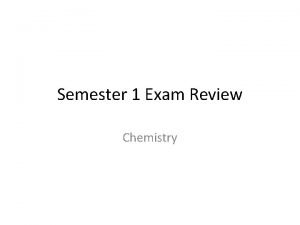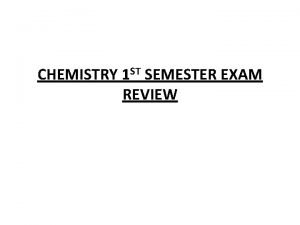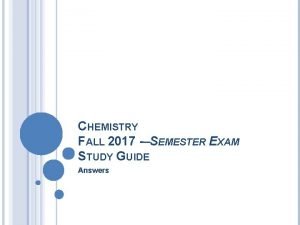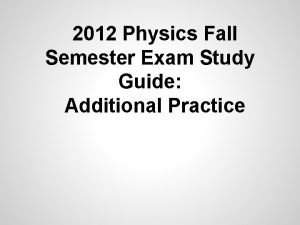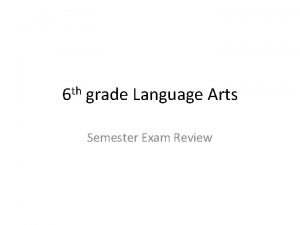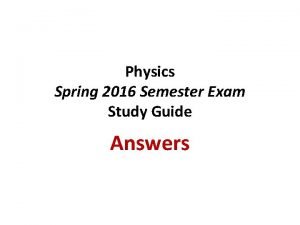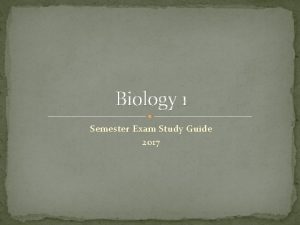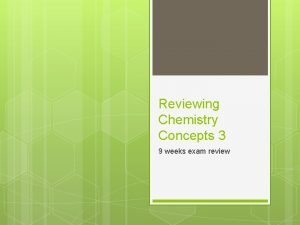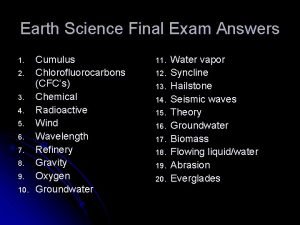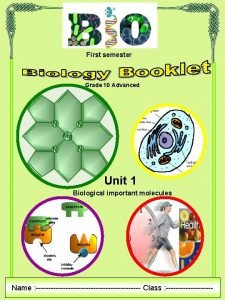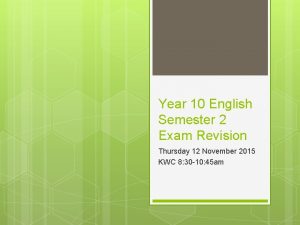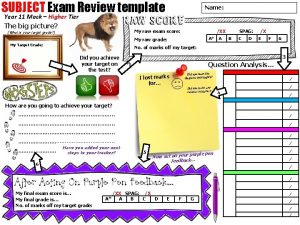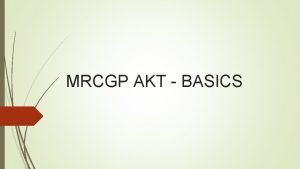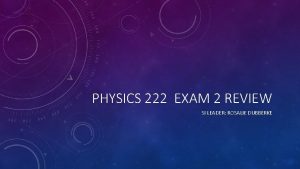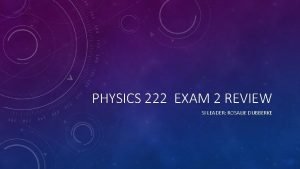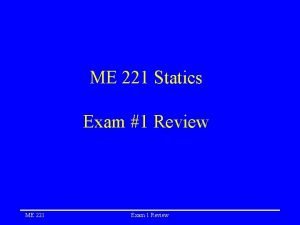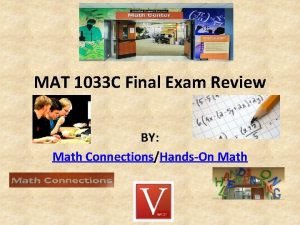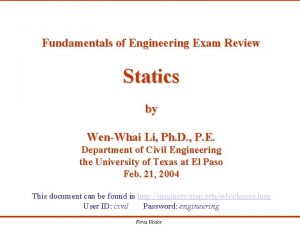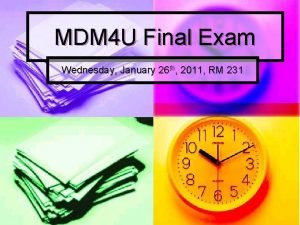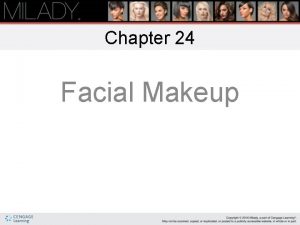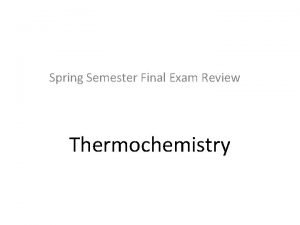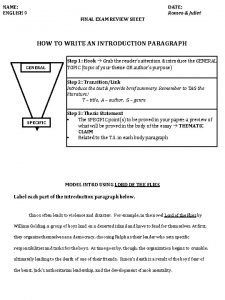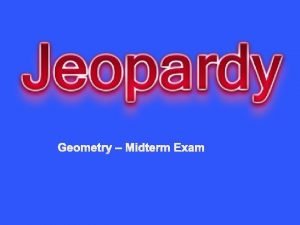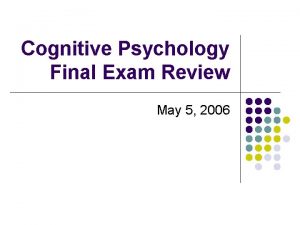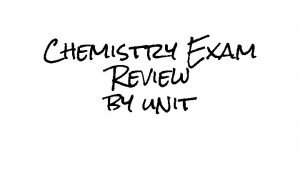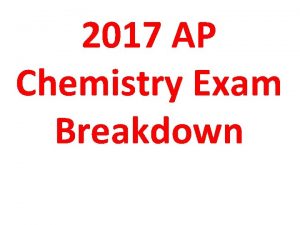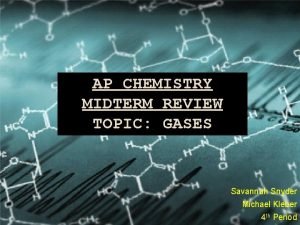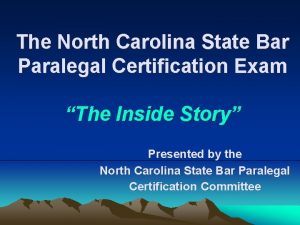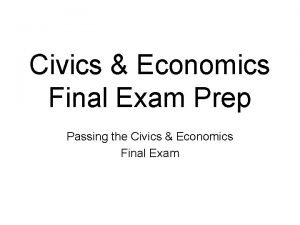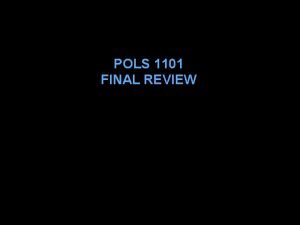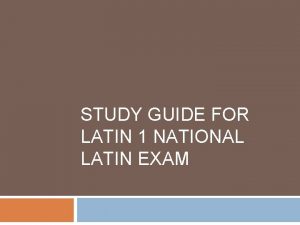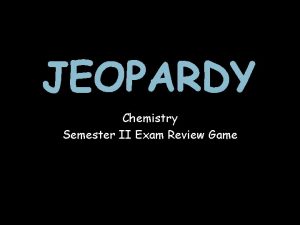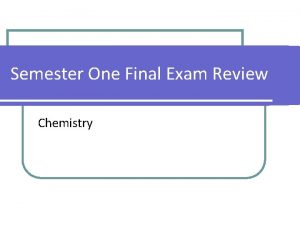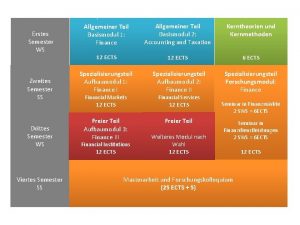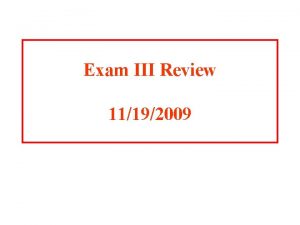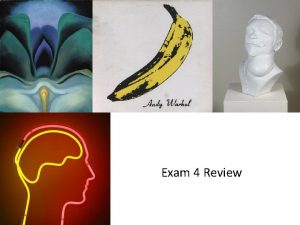Semester 1 Exam Review Chemistry Chemistry The study










































































![Find the period, block, and group • [Ne] 3 s 1 • Period = Find the period, block, and group • [Ne] 3 s 1 • Period =](https://slidetodoc.com/presentation_image/8236e2690493c2f64ab840bd5f5fbc7c/image-75.jpg)
![Find the period, block, and group • • • [Xe] 6 s 2 6 Find the period, block, and group • • • [Xe] 6 s 2 6](https://slidetodoc.com/presentation_image/8236e2690493c2f64ab840bd5f5fbc7c/image-76.jpg)
















- Slides: 92

Semester 1 Exam Review Chemistry

Chemistry • The study of the composition, structure and properties of matter and the changes it undergoes • Physical science • Matter- anything that has mass and takes up space

Basic Research • Used to increase knowledge • How, why, what • Chance discoveries

Applied Research • To solve a specific problem • Example: refrigerants and ozone

• Atom- Smallest unit of element that maintains the properties of that element • Element-Pure substance made of only one kind of atom – Cannot be broken down into simpler substances by chemical means • Compound- Substance made of atoms of two or more different elements that are chemically combined

Mixture • Combination of two or more pure substances in which each substance retains its own composition and properties • Can be separated into pure substances by physical means • No exact chemical formula • Heterogeneous vs homogenous


States of matter • • Solid Liquid Gas Plasma

Physical Properties Chemical Properties • Characteristic that can be observed or measured without changing the identity of the substance • Relates to a substance’s ability to undergo changes that transform it into different substances • Reactivity, flammability, oxidation • Odor, color, volume, state, density, melting and boiling point

Properties • Extensive properties- depend on the amount of matter that is present – Volume, mass, amount of energy • Intensive properties -do not depend on the amount of matter present – Mp, Bp, density, conductivity

Physical Change • Change in physical properties • No change in chemical composition or identity • State of matter change • Breaking, grinding, tearing, melting, dissolving Chemical Change • Composition changes by forming one or more new substances with new properties • Called reactions – Reactants react in chemical change to form Products • Not reversible

Indicators of Chemical change • • • Change in color Odor Production of gas Production of light Production of heat Production of new substance (precipitate)

Periodic Table

Periodic Table • Organization of all elements by chemical and physical properties • Period=Horizontal rows on PT • Group= column, vertical

Metals • • • Shiny Conduct heat Conduct electricity Form cations Most solid at room temp • Malleable • Ductile • Left of zig-zag

Nonmetals • Poor conductors of heat • Form anions and electricity • Low melting point • Brittle • Right of zig-zag • Most are gases

Metalloids • Semiconductor- Conduct electric current better than an insulator, but not as well as a conductor • Some nonmetals and metals • Sometimes considered own group

Two types of Observations • Quantitative – Observations that involve numbers – Ex. There are three birds being fed • Qualitative – The characteristics that cannot be measured or counted – Ex. The girl is feeding the birds, or the birds are eating

Scientific Method • Observe • Formulate hypothesis – Generalizations about data are used to formulate a testable statement • Testing(experiment) • Theorizing • Publish

Independent Variable Dependent Variable Independent Variable • The responding variable • It is determined by the independent variable only, we have no impact • The Y axis on a graph • Ex. Braking Distance • The manipulated variable • We can change this factor • This becomes the X axis on a graph • Ex. Speed of a car

Precision vs. Accuracy

Density = m/v • A material has a mass of 10. 0 g and volume of 6. 0 m. L. What is the density of this material? • 10. 0 g/ 6. 0 m. L= 1. 6 g/m. L • Does is float of sink in water? • Sink, greater than density of water (1. 00 g/m. L)

Percent Error (relative error) – – % Error =Value experimental– Value accepted x 100 – Value accepted – Value is negative if accepted value is greater than experimental value – Value is positive if accepted value is less than experimental value

• What is the percent error for a mass measurement of 17. 7 g, given that the correct value is 21. 2 g? • Percent error= (17. 7 g- 21. 2 g) x 100 =-17% 21. 2 g

Writing Scientific Notation • Examples: • 10000 m=1 x 104 m • 5200000 g = 5. 2 x 106 g • 6230000000 cm =6. 23 x 109 cm • 0. 000071 g = 7. 1 x 10 -5

Derived Units • Most SI units are combination of base units (m, L, g, s) • Made by multiplying or dividing standard units

Metric Quiz • • 1) 24 ng= mg 2) 0. 00046 Gm= mm 3) 25 cm= mm 4) 35670 g = Mg 5) 300000 L = k. L 6) 2900000 µg= g 7) 89 dag= cg 8) 6700000 mg = kg

Metric Answers • 1) 24 ng= 0. 000024 mg • 2) 0. 00046 Gm= 460000000 mm • 3) 25 cm= 250 mm • 4) 35670 g = 0. 03567 Mg • 5) 300000 L =300 k. L • 6) 2900000 µg= 2. 9 g • 7) 89 dag=89000 cg • 8) 6700000 mg =6. 7 kg

• • • Sig Fig Quiz How many digits are significant? 23. 0 20003 0. 0030 700 Round to 4 significant figures. 345. 076 0. 028880 Solve. 3. 45 +16. 709 45 x 4. 567 23 - 2. 01

• • • Sig Fig Quiz How many digits are significant? 23. 0 3 20003 5 0. 0030 2 700 1 Round to 4 significant figures. 345. 076 345. 1 0. 028880 0. 02888 Solve. 3. 45 +16. 709 = 20. 16 45 x 4. 567 = 205. 515= 210 23 - 2. 01= 20. 99= 21

• Law of Conservation of Mass- mass is neither created or destroyed during ordinary chemical reactions or physical changes

John Dalton(1766 -1844) • Dalton’s Atomic Theory 1808 • 1 -All matter is made up of very tiny particles called atoms • 2 - Atoms of a given element are identical in size, mass and other properties; atoms of different elements differ in size, mass, and other properties

• 3 - Atoms cannot be subdivided, created or destroyed • 4 -Atoms of different elements combine in simple whole-number ratios to form chemical compounds • 5 - In chemical reactions, atoms are combined, separated or rearranged

• Dalton turned Democritus’s idea into a scientific theory • Needed to be tested • Problem: – Given element can have atoms with different masses • Isotopes- Could not explain – Atoms are divisible (proton, neutron, electron)

J. J. Thomson (1856 -1940) • Proposed that atoms consist of small, negative electrons embedded in a massive, positive sphere. • The electrons were like currants in a plum pudding • Charge to mass ratio of electrons

Robert A. Millikan (1909) • Determined charge of electron • Oil Drop Experiment

Rutherford Experiment (1911) • Determined atoms mostly empty space (nucleus) • Alpha particles (helium nuclei) fired at thin sheet of gold • Zinc sulfide coated screen surrounding gold foil produced a flash of light with hit by alpha particle • Assumed positively charged particle would bounce back if they approached positively charged • Very few particles were greatly deflected back from gold sheet

Particle Symbol Relative charge AMU Actual Mass Electron e-, 0 -1 e -1 0 9. 109 x 10 -31 Kg Proton p+, 1 1 H +1 1 1. 673 x 10 -27 kg Neutron N 0, 0 1 1. 675 x 10 -27 Kg 1 0 n

• Atomic number= protons • Atomic mass = protons and neutrons

Can you find protons, neutrons, electrons for an element from the periodic table? Copper 29 + 29 e 35 n Rubidium 37 + 37 e 48 n • Helium – 2+ – 2 e – 2 n – – Molybdenum 42 + 4254 n

Nuclear Symbol AZ X A= mass Z= atomic number X= element symbol

• Nickel • 59 28 Ni • Nitrogen • 14 N 7 • Silver • 108 Ag 47

Isotopes • Atoms of the same element that have different masses – same number of protons as other atoms of that element but different number of neutrons • Most common isotope found on PT • Most do not differ significantly in their chemical behavior • Hyphen notation (element symbol – mass) • C-12 • U-238

Can you do this? ? ?


Atomic Mass of ? ? ? Isotopes 6 X = 7 X = Mass of Isotope Abundance 6. 015 amu 7. 016 amu 7. 50 % 92. 5% (6. 015 amu)(0. 0750)+ (7. 016 amu)(0. 925) = 0. 451 amu + 6. 49 amu = 6. 94 amu Lithium

• Isotope Mass (amu) Percent Abundance • 63 X 62. 930 69. 17 • 65 X 64. 928 30. 83 • Calculate the atomic mass of each element described above. • 63 - (62. 930 amu)(0. 6917)=43. 53 amu • 65 – (64. 928 amu) (0. 3083)= 20. 02 amu • 63. 55 amu Identify the element using the periodic table. Copper Which isotope of X is most abundant? 63 Which isotope of X has the most effect on the atomic mass of X? Explain why? • 63 • • •

• Mole- The amount of a substance that contains as many particles as there atoms in exactly 12 g of carbon-12 – SI base unit used to measure the amount of substance • Avagadro’s number – 6. 022 x 10 23 – Number of particles in 1 mol • 6. 022 x 1023 particle of sugar in 1 mol

Mole to mass (g) conversion Number of moles x number of grams 1 mole 3. 00 mol K x 35. 09 g K = 105 g K 1 mol = mass

Mass (g) to Mole Mass x 1 mole = Number of moles number of grams 45. 6 g Ca x 1 mol = 1. 14 mol Ca 40. 08 g Ca

Mass(g) to Atoms (Particles) • Mass x 1 mol x 6. 022 x 10 23 atoms = atoms grams mol 23. 5 g Li x 1 mol x 6. 022 x 10 23 atoms = 2. 04 x 10 24 atoms Li 6. 94 g Li 1 mol

Atoms (particles) to Mass (g) • Atoms x 1 mol x grams • 6. 022 x 10 23 atoms 1 mol = Mass 3. 45 x 1015 atoms S x 1 mol x 32. 07 g S = 1. 84 x 10 -7 g S 6. 022 x 10 23 atoms 1 mol

• Photon- particle of electromagnetic radiation having zero rest mass and carrying a quantum of energy • light as a stream of tiny particles of energy (particle of light) • Light divided into classes by wavelength


Waves • 1 - Wavelength- λ(lambda) distance (m) between 2 crests or 2 troughs • 2 - Frequency- ν(nu) how many waves pass a point per second • w/s or Hertz (Hz) • 3 - Speed- distance per time – C= 3. 00 x 108 m/s speed of light CONSTANT – Speed c= vλ

What is the wavelength of a microwave having a frequency of 3. 44 x 10 9 Hz? § c= vλ § 3. 00 x 108 m/s= (3. 44 x 10 9 Hz) λ § λ= 8. 72 x 10 -2 m

What is the energy of a wave with a frequency of 9. 50 x 10 13 Hz? • E= hv • E= (6. 626 x 10 -34 Js)(9. 50 x 10 13 Hz ) • E= 6. 29 x 10 -20 J

• Wavelength and frequency inverse relationship • Frequency and energy are directly related

Bohr Model (1913) • Niels Bohr- Nobel prize in 1922 • Proposed hydrogen atom model that linked the atoms electron to photon emission – Electrons in fixed orbits around nucleus (planetary model) – Electrons in orbitals, those farthest from the nucleus have more energy

Orbital • Orbital is a three-dimensional region around the nucleus that indicates the probable location of an electron. • Probability based • Gives no information when an electron occupies a point or how it moves • Just tell probability of being in area • Closer to nucleus, greater probability of finding electron

Quantum Numbers • Principal • n • Indicates the main energy level occupied by the electron • Angular • l • sublevels - Indicates shape of orbital, s, p, d, f

Magnetic m Describes the orientation of the orbital in space – xyz indicate which axis it lies on (3 dimensional) – Farther from the nucleus the more orbitals S= 1 sphere (2 electrons) P= 3 dumbbell (6 electrons) D= 5 (10 electrons) F= 7 similar to d (14 electrons) • Spin – Spin of electrons, clockwise or counterclockwise – Orbital can hold only 2 electrons with opposite spins


Rules Governing Electron Configurations • 1 -Aufbau principle- an electron occupies the lowest-energy orbital that can receive it • 2 - Pauli Exclusion Principle : no two electrons can have the same set of four quantum numbers • atomic orbital can hold only 2 electrons and they must have opposite spins (use arrows) • 3 - Hund’s rule- orbitals of equal energy are each occupied by one electron before any orbital is occupied by a second electron • All electrons in singly occupied orbital must have the same spin

• • Li 3 e 1 s 2 2 s 1 Ca 20 e 1 s 2 2 p 6 3 s 2 3 p 6 4 s 2 P 15 e 1 s 2 2 p 6 3 s 2 3 p 3 Rn 86 e 1 s 2 2 p 6 3 s 2 3 p 6 4 s 2 3 d 10 4 p 6 5 s 2 4 d 10 5 p 6 6 s 2 4 f 14 5 d 10 6 p 6

Orbital Notation • P 1 s 2 2 p 3 3 s 2 3 p 3 Orbital diagram = • ↓↑ ↓↑ ↓↑ ↑↓ • 1 s 2 s 2 p 3 s • F 1 s 2 2 p 5 Orbital diagram = • ↓↑ ↓↑ ↑↓ ↑↓ ↑ • 1 s 2 s 2 p ↑ ↑ ↑ 3 p

Noble gas notation (Shorthand) • Na 11 e- 1 s 2 2 p 6 3 s 1 • [Ne] 3 s 1 • Use last element (Noble gas) from previous row • Kr 36 e • [Ar] 4 s 23 d 10 4 p 6 • Ni 28 e • [Ar] 4 s 2 3 d 8

Name the element/ion • • • 1 s 2 2 p 6 3 s 1 Na [Ar] 4 s 23 d 10 4 p 6 Kr [Ar] 4 s 23 d 10 4 p 6 – What ion? • Se 2 - Br- Rb+ Sr 2+

Dimitri Mendeleev • • Russian chemist 1869 first publish PT Organization 1 -Vertical Column in atomic weight order – Made exceptions to place elements in rows with similar properties • Tellurium and iodine switched • 2 -Horizontal rows have similar chemical properties

Henry Moseley • 1911 • English scientist working with Rutherford examined spectra of 38 metals • Protons and atomic number – 1 -Xray experiments revealed a way to determine the number of protons in nucleus of atom – 2 - periodic table in atomic number order, not atomic mass order • Tellurium-iodine anomaly explained

Periodic Law • Physical and chemical properties of the elements are periodic functions of their atomic numbers


• • • Period Group Blocks Group names

Valence Electrons • Most atoms want Octet- atoms lose, gain, or share electrons to get full valence set • Know how to find for group.
![Find the period block and group Ne 3 s 1 Period Find the period, block, and group • [Ne] 3 s 1 • Period =](https://slidetodoc.com/presentation_image/8236e2690493c2f64ab840bd5f5fbc7c/image-75.jpg)
Find the period, block, and group • [Ne] 3 s 1 • Period = # of s orbital – 3 • Block= what orbital is filling last –s • Group= s + p (add d if present) • Remember f block elements don’t have group number • 1
![Find the period block and group Xe 6 s 2 6 Find the period, block, and group • • • [Xe] 6 s 2 6](https://slidetodoc.com/presentation_image/8236e2690493c2f64ab840bd5f5fbc7c/image-76.jpg)
Find the period, block, and group • • • [Xe] 6 s 2 6 th, s, 2 metal [Kr] 5 s 1 5 th, s, 1 metal [Ar] 4 s 2 4 th, s , 2 metal [Ar] 4 s 2 3 d 8 4 th, d, 10 metal • • • [Kr] 5 s 2 4 d 10 5 th, d, 12 metal [Ar] 4 s 2 3 d 10 4 p 3 4 th, p, 15 metalloid [Ne]3 s 23 p 3 3 rd, p, 15 nonmetal


Ionization Energy Trend



Trends • • • Largest radius Cu Cu 2+ At At -1 Greatest electronegativity F Be N Bi Smallest Atomic radius K Br Be Ba

• Smallest ionization energy • I Sr • Li Fr

Ions • Charged particle due to losing or gaining electrons • Cation= lost electrons • Metals • Anions= gained electrons • nonmetals

• • Which has a larger atomic radii? Cl- Cl Sr +2 Sr S 2 - S


Types of Bonds • Ionic Bonding- electrostatic force that holds oppositely charged particles together – Electrons transferred – Between metals and nonmetals – Metal and oxygen= oxide – Metal and halogen= salt

Covalent Bond • Covalent bonding- sharing of valence electrons between two atoms – Between 2 nonmetals – Sharing electrons to fill valence and be stable – Sometimes called molecular bond – Molecule-forms when two or more atoms bond covalently – Neutral

Lewis dot structure • Draw structure using Octet and Duet rules • Polarity • Lone pair vs bonding pair • • Examples: N 2 CCl 4 H 2 S

Electronegativity • Ability of an atom to attract electrons in a chemical bond • Difference between electronegativity between atoms • Less than 0. 3 non-polar covalent (less than 5% ionic character) • 0. 4 -1. 7 polar covalent (between 5 -50% ionic character) • 1. 7> ionic (greater than 50% ionic character)

Electronegativity Values for Selected Elements 90 Copyright © Cengage Learning. All rights reserved

Use electronegativity differences to classify bonding • • • S and H 2. 5 - 2. 1= 0. 4 Non polar covalent S and Cs 2. 5 -0. 7= 1. 8 Ionic S and Cl 3. 0 - 2. 5 = 0. 5 Polar covalent • • • Ca and Cl 3. 0 -1. 0 =2. 0 Ionic Cl and O 3. 5 -3. 0 = 0. 5 Polar covalent Cl and Br 3. 0 -2. 8 = 0. 2 Non polar covalent

• • • Which bond is most polar? C-Br 0. 3 Si-O 1. 7 C-O 1. 0 C-Cl 0. 5
 Chemistry
Chemistry Us history semester 1 final exam study guide answers
Us history semester 1 final exam study guide answers Chemistry first semester exam review
Chemistry first semester exam review Chemistry semester exam study guide
Chemistry semester exam study guide World history semester 2 final exam review
World history semester 2 final exam review Us history final semester 2 review
Us history final semester 2 review Zoology semester 1 exam review answers
Zoology semester 1 exam review answers Physics fall semester exam review
Physics fall semester exam review Us history final exam study guide
Us history final exam study guide English 3 fall semester exam review
English 3 fall semester exam review English 3 fall semester exam review
English 3 fall semester exam review Physics semester 1 final exam study guide answers
Physics semester 1 final exam study guide answers Biology 1st semester exam study guide
Biology 1st semester exam study guide World history semester 1 final exam study guide answers
World history semester 1 final exam study guide answers Chemistry semester 2 review unit 12 thermochemistry
Chemistry semester 2 review unit 12 thermochemistry Uncontrollable spending ap gov
Uncontrollable spending ap gov 3rd 9 weeks exam review chemistry
3rd 9 weeks exam review chemistry English 2 final exam review
English 2 final exam review Difference between lytic and lysogenic cycle
Difference between lytic and lysogenic cycle Earth science semester 2 final exam answers
Earth science semester 2 final exam answers Algebra 1 semester 2 final review
Algebra 1 semester 2 final review Spanish final exam review packet answer key
Spanish final exam review packet answer key Grade 10 biology unit 1
Grade 10 biology unit 1 English 12 semester 1 exam
English 12 semester 1 exam Accounting semester 1 exam
Accounting semester 1 exam Michelle felt an electrical shock when she was ironing
Michelle felt an electrical shock when she was ironing Apes semester 1 final exam
Apes semester 1 final exam English semester exam
English semester exam World history semester exam
World history semester exam Honors physics semester 2 review
Honors physics semester 2 review World history semester 2 final review packet
World history semester 2 final review packet Geometry unit 1 review
Geometry unit 1 review Biology semester 1 review 2018
Biology semester 1 review 2018 World history spring final exam review answers
World history spring final exam review answers Exam review template
Exam review template Spanish 2 exam review
Spanish 2 exam review Pltw human body systems final exam
Pltw human body systems final exam Poe practice test - materials answer key
Poe practice test - materials answer key Gp akt sample questions
Gp akt sample questions Ied final exam review
Ied final exam review Hbs eoc study guide
Hbs eoc study guide Principles of business final exam answer key
Principles of business final exam answer key Bm3final
Bm3final Environmental science final study guide
Environmental science final study guide Apes ap exam review
Apes ap exam review World history final exam study guide
World history final exam study guide Review for exam pronouns
Review for exam pronouns Physics fall final exam review
Physics fall final exam review Eduqas oer
Eduqas oer Sph3u exam review
Sph3u exam review Physics 1 exam 2 review
Physics 1 exam 2 review Physics exam 2 review
Physics exam 2 review Physical science final exam study guide
Physical science final exam study guide Statics exam 2 review
Statics exam 2 review Mat1033 final exam
Mat1033 final exam Fe exam statics
Fe exam statics Earth science sol review
Earth science sol review Mdm4u exam review
Mdm4u exam review Hft 2401
Hft 2401 Personal finance final exam review
Personal finance final exam review What is the purpose of face shape altering makeup
What is the purpose of face shape altering makeup Thermochemistry exam review
Thermochemistry exam review English ii final exam
English ii final exam Wjec a level electronics
Wjec a level electronics Romeo and juliet final exam study guide
Romeo and juliet final exam study guide Bisexts
Bisexts Psyc 1504 final exam
Psyc 1504 final exam Algebra 2 midterm review answers
Algebra 2 midterm review answers Chm 151 final exam
Chm 151 final exam Unit 6 chemistry review
Unit 6 chemistry review 2017 ap chem exam
2017 ap chem exam Ap chemistry midterm exam
Ap chemistry midterm exam World history final exam study guide
World history final exam study guide Nc paralegal exam
Nc paralegal exam Nocti computer programming practice test
Nocti computer programming practice test Civics and economics final exam study guide
Civics and economics final exam study guide Zoology final exam study guide
Zoology final exam study guide Pols 1101 midterm
Pols 1101 midterm My father said to me you must work hard
My father said to me you must work hard National latin exam answers
National latin exam answers Abfm exam practice questions
Abfm exam practice questions How to study for biology keystone exam
How to study for biology keystone exam Certified government finance officer
Certified government finance officer Pe nuclear
Pe nuclear Hình ảnh bộ gõ cơ thể búng tay
Hình ảnh bộ gõ cơ thể búng tay Frameset trong html5
Frameset trong html5 Bổ thể
Bổ thể Tỉ lệ cơ thể trẻ em
Tỉ lệ cơ thể trẻ em Voi kéo gỗ như thế nào
Voi kéo gỗ như thế nào Thang điểm glasgow
Thang điểm glasgow Chúa sống lại
Chúa sống lại Các môn thể thao bắt đầu bằng tiếng bóng
Các môn thể thao bắt đầu bằng tiếng bóng Thế nào là hệ số cao nhất
Thế nào là hệ số cao nhất
